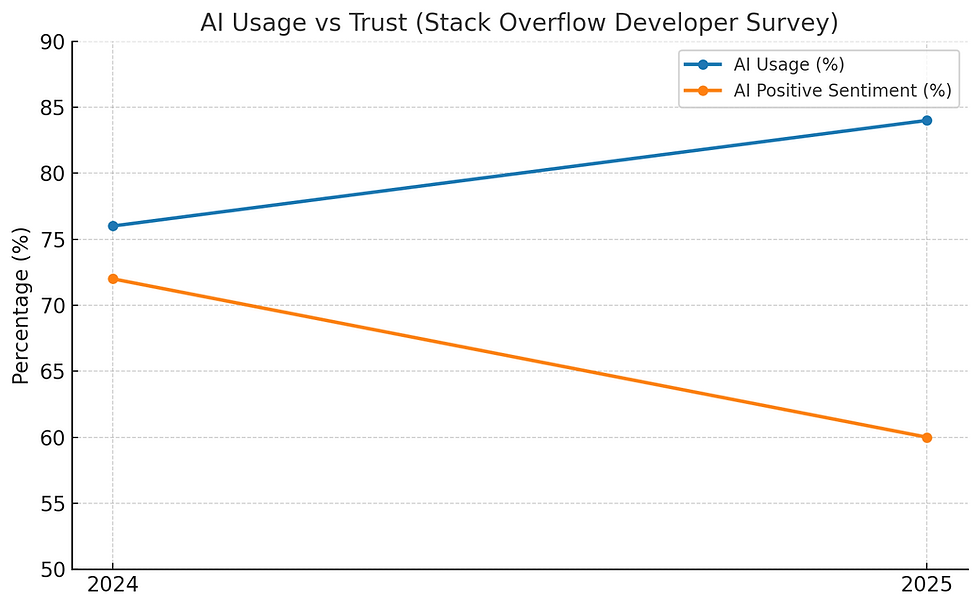AI Is Like a Caffeinated Intern: Fast, But Demands Supervision - Stack Overflow Developer Survey 2025
- Krzysztof Kosman

- Aug 11
- 4 min read
Once a year, Stack Overflow publishes what is effectively the world’s most detailed developer census. The 2025 edition gathered over 49,000 responses from 166 countries (source), covering everything from the languages we love to the tools we loathe, our relationship with AI, and the way we work.
These surveys are more than a snapshot — they’re an early-warning system for the IT market.
Technologies that make big jumps here often go mainstream within two years. Trends in hiring, workflow, and sentiment ripple through product roadmaps, VC investment, and skills demand.
Compared with 2024, the 2025 results tell a story of AI ubiquity meeting growing skepticism, steady platforms holding their ground, and niche tools quietly building passionate followings.
AI: Fueling Speed, Eroding Trust
Adoption is soaring:
84% of developers use or plan to use AI tools (up from 76% in 2024).
Among professionals, 51% use AI daily.
This is an unprecedented pace of adoption — faster than Docker in its prime or Git when it became standard.
But sentiment is cooling:
Positive views of AI have dropped from 72% in 2024 to around 60% in 2025.
Distrust has climbed to 46%, up from 31% last year.

The number one complaint? “AI gives almost correct answers” (66% of respondents). That “almost” is where the trouble lies. AI is moving teams faster toward a result — but the result often needs deeper debugging and review than the same task would if done manually.
Market impact: This is the classic disillusionment phase in the Gartner Hype Cycle. We’ve passed the initial honeymoon and are now wrestling with the reality: AI is a force multiplier for speed, not judgment.
For IT leaders, the next wave of value will come not from plugging in more AI tools, but from building governance layers — automated QA gates, AI-specific test suites, and process design that balances speed with verification.
Technologies: Stable Favorites and Rising Stars
The staples hold: JavaScript, PostgreSQL, and Python still dominate. Rust and Markdown retain their place as the most admired language and markup format respectively. This stability signals that while AI dominates the headlines, the underlying technology stack isn’t being rewritten every year.
Rising admiration:
Cargo (Rust’s package manager) tops the cloud tool admiration chart.
Among LLMs, Claude Sonnet is the most admired, closely followed by Gemini Reasoning.

These are not yet the most-used tools — but admiration tends to be a leading indicator. In The state of software development, we’ve seen how admiration often predicts future hiring demand, as developers try to bring their favorite tools into their work.
Market impact: Admired-but-niche tools often mark the edge of the adoption curve. For startups, betting on these early can create recruiting advantages and brand differentiation. For enterprises, they are signals for where talent pipelines may get tighter in the next 2–3 years.
Remote and Flexible Work: A Pragmatic Turn
~32% of developers work fully remote.
12.6% enjoy a “your choice” model — total flexibility in choosing workplace.
The shift from 2024’s heated “remote vs. office” debate to a calmer, pragmatic distribution is striking. Companies are no longer choosing work models based on ideology or PR optics; they’re optimizing for outcomes.
Market impact: This flexibility is reshaping the geography of IT talent. Skilled developers can choose employers worldwide, and companies can blend distributed and local teams without the cultural friction we saw in 2021–2022. But it also increases competition for talent — your “local” candidate pool is now global.
Community: Stack Overflow’s Resurgence
Despite predictions of decline, Stack Overflow engagement is rising:
81% have accounts (up from 76% in 2024).
82% visit several times a month.
Many visits are to verify or correct AI-generated answers.
This mirrors what we explored in Vibe coding — the social, human aspect of programming hasn’t disappeared in the AI era. If anything, AI has amplified the value of trusted, human-vetted information.
Market impact: For developer tools and platforms, this reinforces the importance of community trust. AI assistants may reduce “first-question” traffic, but they also generate demand for second-opinion validation — a role communities are uniquely equipped to fill.
The Bigger Picture: Where This Leads the IT Market
Looking across the 2025 survey, a few patterns emerge:
AI is entering its “professionalization” phase. The tooling arms race is giving way to process integration. Expect demand for AI governance platforms, compliance frameworks, and developer training focused on “AI QA.”
Stability in core stacks means more energy for the edges. With JavaScript, Python, and PostgreSQL entrenched, developer excitement flows into edge tech like Cargo, Phoenix, and Claude Sonnet. These edges are where cultural and recruitment advantages can be won.
Workplace flexibility is here to stay, but without the hype. Hiring will be increasingly global, and teams will be built around outcome-based flexibility rather than slogans.
Communities are the new quality gate. AI makes content creation trivial; curation, verification, and trust become premium assets. This is why Stack Overflow’s traffic is not just holding, but growing.
Conclusions from Stack Overflow Developer Survey 2025
The 2025 survey captures a maturing market: AI is embedded in daily workflows but no longer seen as infallible; beloved tools keep their place while niche favorites gather momentum; remote work is no longer a culture war but a logistical choice; and human communities remain central to developer life.
For product builders, team leaders, and investors, the message is consistent:
Invest in AI oversight, not just AI output
Watch admired tools for early hiring and tech adoption signals
Treat flexibility as a design parameter, not a perk
Nurture community trust as a strategic advantage
The caffeinated intern is here to stay. Just make sure you’re still the one signing off before the code ships.
References:


